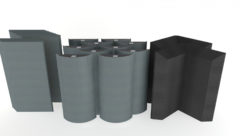What Good Are Power Ratings?
One of the sacred cows of the audio industry, the loudspeaker power rating is likely the most widely recognized specification, and undoubtedly one of the most useless.
MANY YEARS ago I was setting up a demo for one of the guest instructors at a Syn-Aud-Con Loudspeaker Designer’s Workshop. Bruce Howze of Community Professional Loudspeakers handed me a box and said, “Put 10 volts RMS of pink noise across this.” He knew exactly what to expect from the box with that signal, and it was a simple matter to comply. Now, if he had said, “Put x watts to this,” I would have been clueless. And if I had asked him, “How many watts is that?” he would have undoubtedly said, ”Who cares?” From that point on, I’ve questioned the usefulness of loudspeaker power ratings.
There are several common phrases that indicate the misconceptions about power ratings. “My speaker is putting out 500 watts!” One would hope not. Loudspeakers don’t produce electrical power, and 1 W is a formidable amount of acoustic power.
“The Killsound 5000 will take 1,000 watts!” Where’s all that power going? With a power rating that high, it’s likely that the loudspeaker is very inefficient and that the same loudness could be achieved with far less applied power with a different model. Inefficient loudspeakers make pretty good space heaters.
“The Stack-n-Blast 500 handles twice as much power as the Killsound 250!” A 2-to-1 power ratio isn’t a significant difference. Even if both ratings were arrived at using identical measurement techniques (not likely), and both products have identical sensitivity ratings (even more unlikely), the SNB500 would only be slightly louder (+3 dB) than the KS250. Power tests, even properly conducted ones, can easily deviate by 3 dB due to the number of variables involved. If any of these statements raise an eyebrow, read on.
The purpose of a specification is to provide meaningful information to aid in the selection and implementation of a product. Loudspeaker power ratings don’t. Consider the facts:
- A loudspeaker power rating isn’t the suggested amplifier size.
- Bigger isn’t necessarily better, which can mislead those unfamiliar with the reasoning behind it.
- All too often information on how it was measured either isn’t included or is ambiguous.
- Power dissipation isn’t easily measured in the lab, and is almost never measured in the field.
- Power ratings taken at face value can lead to inappropriate loudspeaker and amplifier buying decisions.
So what good is a rating that can’t be verified in the field, accurately monitored in real time, or even used to set an amplifier level control? Not much good at all. It’s true that some of the newer amplifiers can monitor both voltage and current during actual use. Because power equals voltage multiplied by current, these amplifiers can accurately indicate the power being generated by the amplifier.Unfortunately this has little to do with the loudspeaker’s power rating. It’s not hard to find loudspeakers with 1,000 W ratings that literally catch fire at one-tenth of this value. And, it’s not hard to find 500 W amplifiers that are only generating 50 W at clipping due to the high average impedance of the loudspeaker and the high crest factor of the test signal. Now, there’s also nothing wrong with the loudspeaker or amplifier in these examples. The problem stems from the methods used to rate them.If you look in an audio technician’s toolbox, you won’t find a power meter. But any good tech will have a true RMS voltmeter — an invaluable device for setting up and troubleshooting a sound system. Some voltmeters include a power scale, but the indication is calculated from the measured voltage across assumed impedance. That’s fine if you’re the phone company working with well-defined and standardized resistive loads, but it isn’t useful for describing what’s happening with a loudspeaker whose impedance can vary by a 10-to-1 ratio or more across its bandwidth. While we can always simplify this and express it as nominal impedance (i.e. 8 ohms), that’s not reality and the resultant power specifications calculated from the nominal impedance don’t describe what’s really going on in the amplifier-to-loudspeaker interface.Fortunately there’s a linear relationship between the applied RMS voltage and the sound level produced by the loudspeaker over its useful operating range. You start with knowledge of the SPL produced at 1 meter with 2.83 V RMS applied to the loudspeaker (the loudspeaker sensitivity rating). The SPL will predictably rise with an increase in the applied voltage, where every doubling of voltage produces 6 dB of additional SPL. When this relationship becomes non-linear (i.e. the onset of power compression due to voice coil heating), then one should back off the drive voltage to prevent distortion and possible damage. So what you really need to know is the maximum RMS voltage that you can put across the loudspeaker. This can sometimes be derived from a power rating, but only after some mathematical acrobatics and possibly a few assumptions.One can never be certain of how much power they’re feeding a loudspeaker. The power flow is dependent upon both the constantly changing characteristics of the program material and the impedance of the loudspeaker. The impedance is frequency-dependent, which means that the current draw will be different for different parts of the spectrum. Sine waves of differing frequency, but within the pass band of the loudspeaker, will generate different amounts of power into the loudspeaker, even though the on-axis SPL at all frequencies may be about the same.
Power ratings for loudspeakers are really voltage ratings in disguise. They’re determined by measuring the RMS voltage across the loudspeaker terminals from a well-defined broadband waveform. This voltage is squared and then divided by the “nominal” impedance of the loudspeaker (Ohm’s Law). The nominal (or “named”) impedance and the actual impedance can vary significantly. The nominal impedance is typically far lower than the average, and always produces a much larger power rating than what the loudspeaker is actually drawing during the test. As such it isn’t a true power rating, but a voltage rating expressed as wattage using an assumed loudspeaker impedance. The only accurate parameter about the test is the RMS voltage.
Because larger power ratings are highly esteemed by (and impressive to) novice end-users, there’s pressure on manufacturers to provide big ones. A low power rating can be the “kiss of death” for a superb loudspeaker, while a vastly inferior design with a large power rating will likely generate more sales. Ironically there’s no need for a highly efficient loudspeaker to have a large power rating, because it won’t take lots of watts to produce the target SPL. There’s a penalty for being accurate with power specifications.
What makes sense?
A sound system designer needs to know at least two things about a loudspeaker. The first is the on-axis SPL produced by the application of a known voltage to the loudspeaker. The value most commonly used is 2.83 V RMS. The second is the maximum RMS voltage of a broadband stimulus (i.e. shaped pink noise) that the loudspeaker can safely handle over time. A technician can monitor this with a voltmeter. Conversion of this voltage to a power rating is an additional (and largely unnecessary) step.
Kudos to the loudspeaker manufacturers that give maximum V RMS ratings for their products. Others are encouraged to investigate further. A number of articles on the subject are available at www.etcinc.us. The new Common Loudspeaker File Format provides for the inclusion of voltage ratings, along with a conversion to an amplifier power rating that will pass the voltage waveform.
Let’s give audio technicians a metric they can use in the field, and sound system designers a metric that can be used to accurately predict the achievable SPL of a sound system at the drawing board stage of a project. We need only to substitute “RMS volts” for “power” on our spec sheets to do so.
Pat Brown is president of Synergetic Audio Concepts (Syn-Aud-Con) Inc. and Electro-Acoustic Testing Company (ETC) Inc. Syn-Aud-Con conducts training seminars in audio and acoustics worldwide for those who operate, install, and design sound reinforcement systems. ETC Inc. performs precision loudspeaker testing for the audio industry. He can be reached at[email protected].










